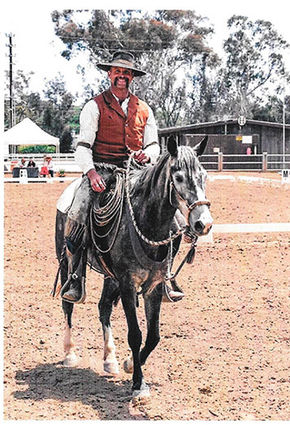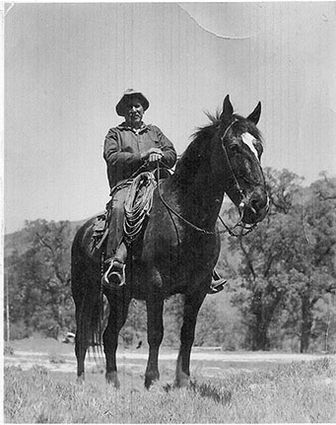Anselmo, a vaquero - Part II
The Spirit of Tehachapi
The Tejon Rancheria was a good home for Andres Campas and his family. Anselmo and his brother, Julio, received kind care and a good education in the work of a cowboy. Fort Tejon and the Rancheria were part of four Spanish land grants; all who would be purchased by Gen. Beale. From 1854 through 1864 the Army protected the people of the surrounding areas from conflicts between settlers and Indians but mostly guarded against outlaws and cattle rustlers; a constant problem. The residents on the Tejon Rancheria worked for Edward Beale who paid them and had buildings constructed for their use, including a church.
Reaching back into the waning years of the Nineteenth Century would find Anselmo, not yet twenty years old, but a respected man skilled in the many aspects of horsemanship. Occasionally he would take work elsewhere and at one such time he worked for Bill Cuddy, son of the first settler of Cuddy Valley, near Frazier Park. He hauled borax from Frazier Borax Mine into Bakersfield, an eight day round trip driving twelve mules with a "jerk line." He was known as the best "mule skinner" (a mule driver) in the area.
After the Tejon Rancheria was sold by Edward Beale's son, Truxton Beale, to Harry Chandler, Anselmo still "wrangled horses" and worked there with a friend, Don Jose Jesus Lopez (J.J. Lopez), known as the Major Domo and whom he described as a fine man. Later, upon leaving the Rancheria he gave his good cattle dog to his friend, Mariano. The two men bragged that the dog, an Australian Shepherd, named Pancho, could understand two languages for he could obey commands needed to herd cattle in both English and Spanish. Pancho, the bi-lingual dog, knew his business and would have been unhappy to leave the Rancheria.
Because of Anselmo's talents, employment came easy and the young Native American was employed with the San Joaquin Light and Power Company tending to mule and horse needs as the first power line was built, in 1910, from Kernville to Los Angeles.
Tehachapi area beckoned and he began working for Gordon Brite, a descendant of Tehachapi's first settlers. Cummings Valley was the main location of his employment on land now the site of the California Correctional Facility and beyond.
Romance entered his life and he met and married Maria Ocana, a member of a famous California Spanish family. Maria's mother was Maria de la luz Sais Ocana, a member of the San Anselmo Family located farther north in the state. Anselmo and Maria were to have five children, all born in the Bear Valley and Cummings Valley area. Daughters, Mary, Vickie, and Lucille, plus two boys, Anselmo, Jr. and Tony all attended school in Cummings Valley. Daughter, Mary, would become a nurse and served Tehachapi residents for many decades.
In his later years he would live in Tehachapi taking a house across the street from daughter, Mary Campas Acevedo Rodriguez, and only a few houses from daughter, Vickie Campas Leiva. Vickie's daughter, Charlotte Leiva Villalobos was Anselmo and Maria's granddaughter and as a small child would find her granddad watching for her and coming to meet her when she came for a daily visit. Mary's daughter, named Mary Louise (Dee Dee) Acevedo, considered her grandparents' home her home, also. He always kept two horses and a wagon in town and rides for the grandchildren were given freely.
When his wife, Maria, died in 1933 he left Tehachapi for employment at the old Dairy Farm in Lebec. His daughter, Lucy, went with him to keep house. The young granddaughters, Charlotte and Dee Dee visited often and rode horses under the careful watch of their doting vaquero grandfather.
Back again to Tehachapi from Lebec he stayed with his daughter, Mary, living in a small separate house on the back of the property. The family maintained a closeness which still exists to this day.
Keeping just one horse now he still felt the pull of the Rancheria, a place close to his heart. Sometimes he would ride from town through Brite and Cummings Valley and travel down Cedar Canyon to his boyhood home. Cedar Canyon, behind present day Stallion Springs, was only passable by horseback and not wagon. He would spend a few days renewing acquaintances and then travel back to Tehachapi. When asked where he'd been he'd say, "Oh, I just went home to the ranch for a while."

Modern day, great grandson of Anselmo, Jeremy Dunn has made his life work, that of a modern day vaquero with, it would seem, inherited "genetic genes" using the same gentle method of handling horses.
He lived the remainder of his life among his family, and that life spanned eighty years. He never ran for public office nor did he have a college degree, but was often contacted for historical facts because of his great memory and was a highly respected and honest citizen. The Bakersfield Californian printed a lengthy article when he died. His tombstone, in Westside Cemetery, says: " Anselmo Campas, 1876-1956 A Great Man."
Although this is Anselmo's tale, when it comes to family, the story always continues. Today, his great great grandson, Jeremy Dunn, has made his life work, that of a modern day vaquero with, it would seem, inherited "genetic genes" using the same gentle method of handling horses. He was born just one hundred years after his famous ancestor (Anselmo: April 1876 and Jeremy, April 1976.) His land, the Broken Arrow Ranch, backs up to the Tejon Ranch property. He derives a great satisfaction to be carrying on a valuable method of horse training, teaching others his method and also carrying on a family tradition.





